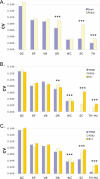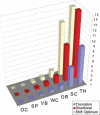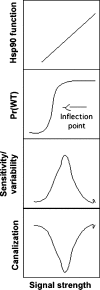Control of canalization and evolvability by Hsp90
- PMID: 17183707
- PMCID: PMC1762401
- DOI: 10.1371/journal.pone.0000075
Control of canalization and evolvability by Hsp90
Abstract
Partial reduction of Hsp90 increases expression of morphological novelty in qualitative traits of Drosophila and Arabidopsis, but the extent to which the Hsp90 chaperone also controls smaller and more likely adaptive changes in natural quantitative traits has been unclear. To determine the effect of Hsp90 on quantitative trait variability we deconstructed genetic, stochastic and environmental components of variation in Drosophila wing and bristle traits of genetically matched flies, differing only by Hsp90 loss-of-function or wild-type alleles. Unexpectedly, Hsp90 buffering was remarkably specific to certain normally invariant and highly discrete quantitative traits. Like the qualitative trait phenotypes controlled by Hsp90, highly discrete quantitative traits such as scutellor and thoracic bristle number are threshold traits. When tested across genotypes sampled from a wild population or in laboratory strains, the sensitivity of these traits to many types of variation was coordinately controlled, while continuously variable bristle types and wing size, and critically invariant left-right wing asymmetry, remained relatively unaffected. Although increased environmental variation and developmental noise would impede many types of selection response, in replicate populations in which Hsp90 was specifically impaired, heritability and 'extrinsic evolvability', the expected response to selection, were also markedly increased. However, despite the overall buffering effect of Hsp90 on variation in populations, for any particular individual or genotype in which Hsp90 was impaired, the size and direction of its effects were unpredictable. The trait and genetic-background dependence of Hsp90 effects and its remarkable bias toward invariant or canalized traits support the idea that traits evolve independent and trait-specific mechanisms of canalization and evolvability through their evolution of non-linearity and thresholds. Highly non-linear responses would buffer variation in Hsp90-dependent signaling over a wide range, while over a narrow range of signaling near trait thresholds become more variable with increasing probability of triggering all-or-none developmental responses.
Conflict of interest statement
Figures






Similar articles
-
Modularity and intrinsic evolvability of Hsp90-buffered change.PLoS One. 2006 Dec 20;1(1):e76. doi: 10.1371/journal.pone.0000076. PLoS One. 2006. PMID: 17183708 Free PMC article.
-
A naturally occurring variant of Hsp90 that is associated with decanalization.Proc Biol Sci. 2010 Jul 7;277(1690):2049-57. doi: 10.1098/rspb.2010.0008. Epub 2010 Mar 3. Proc Biol Sci. 2010. PMID: 20200026 Free PMC article.
-
Quantitative trait symmetry independent of Hsp90 buffering: distinct modes of genetic canalization and developmental stability.Proc Natl Acad Sci U S A. 2003 Nov 11;100(23):13396-401. doi: 10.1073/pnas.1835613100. Epub 2003 Oct 31. Proc Natl Acad Sci U S A. 2003. PMID: 14595030 Free PMC article.
-
The Hsp90 capacitor, developmental remodeling, and evolution: the robustness of gene networks and the curious evolvability of metamorphosis.Crit Rev Biochem Mol Biol. 2007 Sep-Oct;42(5):355-72. doi: 10.1080/10409230701597782. Crit Rev Biochem Mol Biol. 2007. PMID: 17917872 Review.
-
Protein folding sculpting evolutionary change.Cold Spring Harb Symp Quant Biol. 2009;74:103-8. doi: 10.1101/sqb.2009.74.043. Epub 2010 Apr 7. Cold Spring Harb Symp Quant Biol. 2009. PMID: 20375316 Review.
Cited by
-
Pervasive robustness in biological systems.Nat Rev Genet. 2015 Aug;16(8):483-96. doi: 10.1038/nrg3949. Nat Rev Genet. 2015. PMID: 26184598 Review.
-
Network hubs buffer environmental variation in Saccharomyces cerevisiae.PLoS Biol. 2008 Nov 4;6(11):e264. doi: 10.1371/journal.pbio.0060264. PLoS Biol. 2008. PMID: 18986213 Free PMC article.
-
Early developmental conditioning of later health and disease: physiology or pathophysiology?Physiol Rev. 2014 Oct;94(4):1027-76. doi: 10.1152/physrev.00029.2013. Physiol Rev. 2014. PMID: 25287859 Free PMC article. Review.
-
Phenotypic diversity and altered environmental plasticity in Arabidopsis thaliana with reduced Hsp90 levels.PLoS One. 2007 Jul 25;2(7):e648. doi: 10.1371/journal.pone.0000648. PLoS One. 2007. PMID: 17653275 Free PMC article.
-
Distinct metabolic states of a cell guide alternate fates of mutational buffering through altered proteostasis.Nat Commun. 2020 Jun 10;11(1):2926. doi: 10.1038/s41467-020-16804-6. Nat Commun. 2020. PMID: 32522991 Free PMC article.
References
-
- Richter K, Buchner J. Hsp90: chaperoning signal transduction. J Cell Physiol. 2001;188:281–290. - PubMed
-
- Nollen EA, Morimoto RI. Chaperoning signaling pathways: molecular chaperones as stress-sensing ‘heat shock’ proteins. J Cell Sci. 2002;115:2809–2816. - PubMed
-
- Rutherford SL, Zuker CS. Protein folding and the regulation of signaling pathways. Cell. 1994;79:1129–1132. - PubMed
-
- Picard D, Khursheed B, Garabedian M, Fortin M, Lindquist S, et al. Reduced levels of hsp90 compromise steroid receptor action in vivo. Nature. 1990;348:166–168. - PubMed
-
- Cutforth T, Rubin GM. Mutations in Hsp83 and cdc37 impair signaling by the sevenless receptor tyrosine kinase in Drosophila. Cell. 1994;77:1027–1036. - PubMed
Publication types
MeSH terms
Substances
Grants and funding
LinkOut - more resources
Full Text Sources
Molecular Biology Databases

